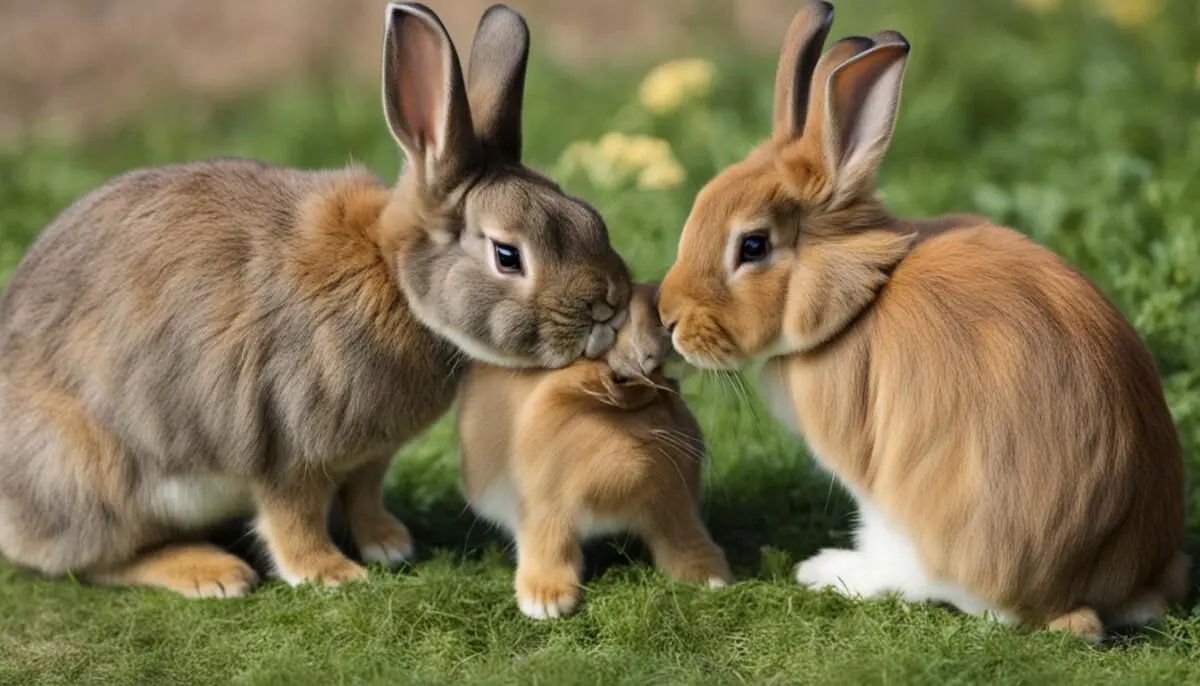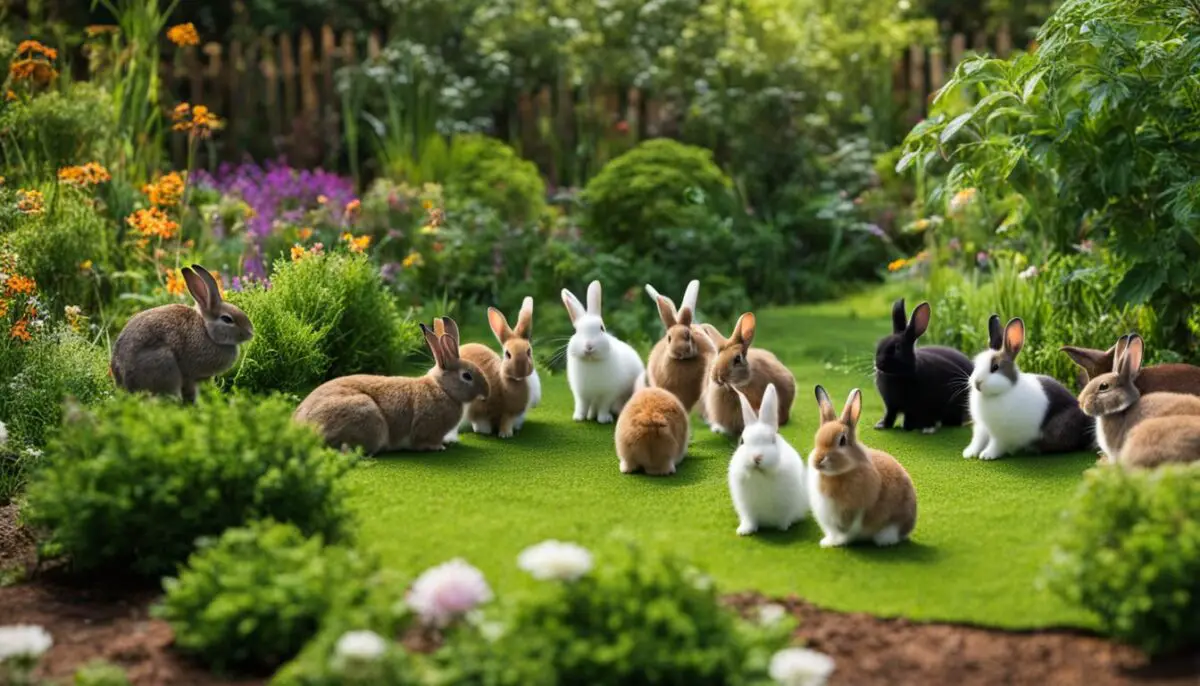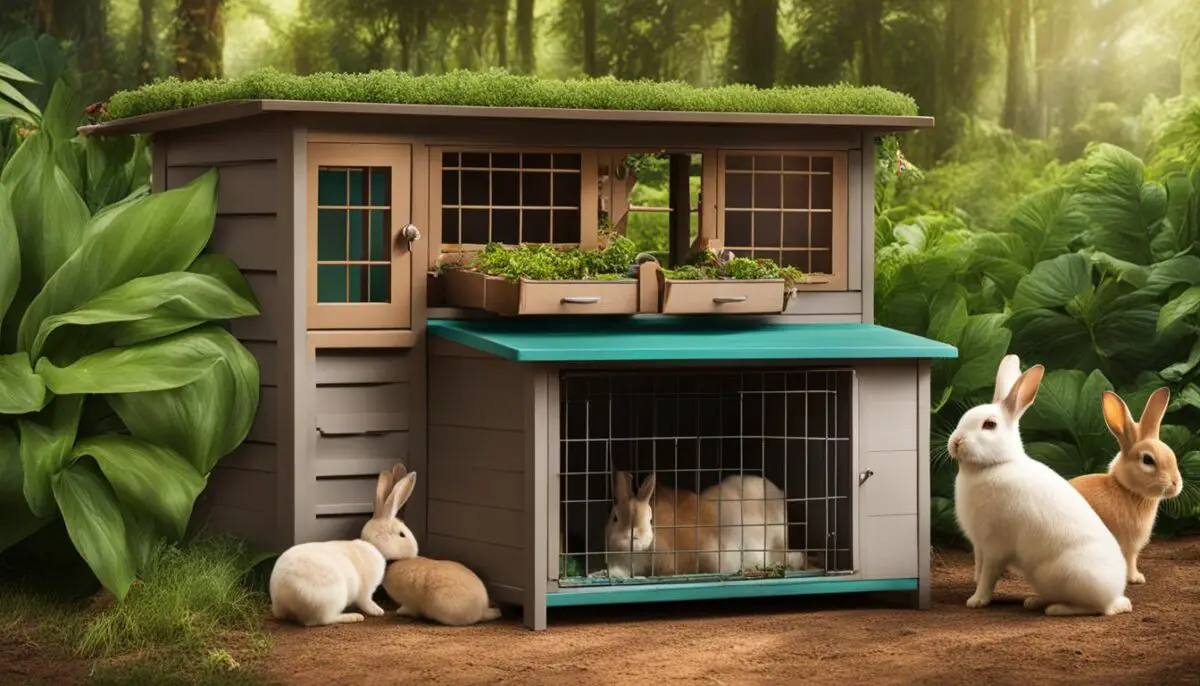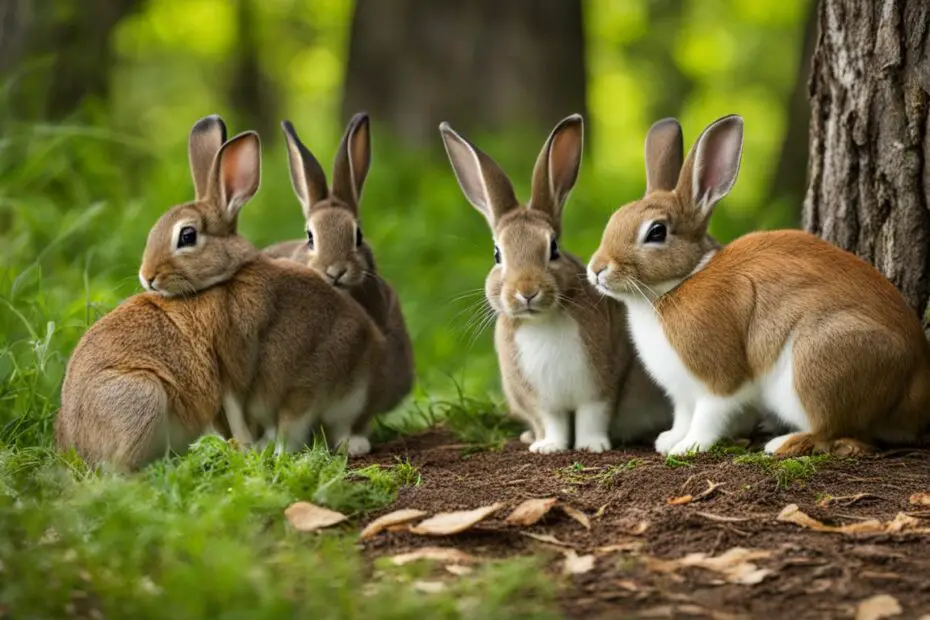Rabbits are delightful companions that bring joy and happiness to our lives. As responsible pet owners, it is essential to understand their social nature and provide them with suitable companionship and habitat. In this article, we will explore the best rabbit companions and how rabbits can cohabitate with other animals.
Key Takeaways:
- Choosing the right companion for your pet rabbit is crucial for their well-being and happiness.
- Rabbits prefer the company of other rabbits, but careful introductions can be made with suitable rabbit-friendly companion animals.
- Introducing rabbits to other species, such as dogs or cats, requires careful supervision and consideration for the safety of both animals.
- Creating an enriched environment with appropriate housing, resources, and opportunities for natural behaviors is essential for your rabbit’s overall well-being.
- When you need to be away, ensure you arrange for responsible care and companionship for your rabbits to prevent loneliness and stress.
Who Do Rabbits Live With
The Importance of Companionship for Rabbits
Rabbits are social animals by nature and thrive when they have companionship. Unlike solitary animals, rabbits benefit greatly from living in groups and having a fellow rabbit as a companion. Providing rabbits with appropriate companionship helps reduce loneliness and prevent stress, contributing to their overall well-being.who do rabbits live with
When rabbits are housed with a companion, they exhibit fewer abnormal behaviors compared to those kept alone. They engage in natural social interactions, such as grooming each other, playing, and communicating through body language. These interactions not only prevent boredom but also create a sense of security and happiness for rabbits.
“Rabbits are happier and healthier when they have a bonded companion to share their life with.”
Having a companion rabbit is especially important for single rabbits who may experience loneliness and lack mental stimulation. A companion provides a source of comfort and emotional support, reducing the risk of stress-related health issues. By providing rabbits with the opportunity to live in groups and form bonds, we can enhance their quality of life.
The Benefits of Rabbits Living in Groups:
- Reduced loneliness and increased mental stimulation
- Prevention of stress-related health issues
- Opportunities for social interactions and natural behaviors
- Enhanced overall well-being and happiness
Conclusion:
Companionship is essential for rabbits, given their social nature. Providing them with a bonded companion not only reduces loneliness and prevents stress but also enhances their overall well-being. By understanding the importance of companionship and promoting social interactions, we can ensure that pet rabbits lead happy and fulfilling lives.compatible pets for rabbits
Rabbit Companions: Bonding and Introductions
Introducing rabbits to each other requires a gradual and supervised process to ensure a successful bond. The rabbit bonding process involves several steps that help the rabbits establish a harmonious relationship. These steps include:
- Initial Introduction: Start by allowing the rabbits to get acquainted with each other’s scent and presence. Place them in separate enclosures side by side, allowing them to interact through a barrier.
- Neutral Territory: When the rabbits have become familiar with each other’s scent, introduce them in a neutral territory. Ensure the area is safe and secure, free from any objects or items that may cause conflict.
- Supervised Interaction: During the initial interactions, closely monitor the rabbits for signs of aggression or stress. Gradually increase the duration of their interactions as they become more comfortable with each other.
- Bonding Enclosure: Once the rabbits have shown positive interactions, create a bonding enclosure where they can spend more time together. This enclosure should be spacious enough to allow them to move around comfortably.
- Living Together: After several successful interactions in the bonding enclosure, the rabbits can be moved into a shared living space. Ensure that there are enough resources such as food, water, and hiding places for both rabbits.
It’s important to note that bonding rabbits can take time, and not all rabbits will bond successfully. If bonding attempts are unsuccessful, it’s best to consult with a rabbit-savvy veterinarian or animal behaviorist for guidance. Each rabbit has a unique personality, and the bonding process may vary for each pair.
“The bond between two rabbits is a delicate and beautiful thing. It takes patience, understanding, and careful observation to create a harmonious companionship.” – Rabbit Enthusiast
| Signs of Successful Bonding | Signs of Unsuccessful Bonding |
|---|---|
| – Grooming each other | – Aggressive chasing and biting |
| – Resting or sleeping together | – Frequent fighting |
| – Sharing food and water without guarding | – Refusing to be in proximity to each other |
| – Playing and exploring together | – Excessive fear or stress behaviors |

The success of rabbit introductions relies on careful monitoring and understanding of their behaviors. Patience is key, as some rabbits may take longer to bond than others. By following the proper steps and providing a safe environment, you can increase the chances of a successful rabbit companionship. rabbits living with other animals
Other Companion Species for Rabbits
While rabbits are social animals that prefer the company of their own kind, it’s essential to consider the compatibility of other species before introducing them to rabbits as companions or cage mates. Not all animals are suitable companions for rabbits, and some can even pose a risk to their safety and well-being.
Rabbits and Guinea Pigs: Although rabbits and guinea pigs are both small herbivorous animals, they have different social needs and communication styles. Rabbits are more energetic and may unintentionally injure guinea pigs during play. Additionally, rabbits have a different diet requirement, as they need a higher amount of fiber. It is best to keep rabbits and guinea pigs separate to prevent stress or harm to either animal.ideal companions for pet rabbits
Rabbits and Dogs/Cats: Dogs and cats are natural predators, and their presence can cause stress and fear in rabbits. Even if your dog or cat is well-behaved and gentle, the natural instincts of these animals can still be a cause for concern. It is recommended to keep rabbits separate from dogs and cats to ensure their safety and well-being.appropriate rabbit cage mates
Keeping Rabbits with Other Pets: While it may be possible for rabbits to coexist peacefully with certain species, such as birds or small rodents, introductions should be done with caution and constant supervision. Always consider the size and predatory nature of other animals before making decisions about cohabitation. The primary concern should always be the safety and welfare of the rabbits.
Table: Compatibility of Rabbits with Other Pets
| Pet | Compatibility |
|---|---|
| Dogs | Not recommended |
| Cats | Not recommended |
| Guinea Pigs | Not recommended |
| Birds | Proceed with caution and constant supervision |
| Small Rodents (e.g., hamsters, gerbils) | Proceed with caution and constant supervision |
Remember, the primary concern when considering companions for rabbits is their safety and well-being. If you are unsure about introducing rabbits to other pets, consult with a knowledgeable veterinarian or animal behaviorist who can provide guidance and expertise.
Rabbits and Human Companionship
Rabbits are not only social animals with their fellow rabbits but can also form close bonds with humans. Interacting with your pet rabbit can be a rewarding experience and contribute to their overall well-being. However, it is important to understand how to handle and socialize with rabbits properly. socializing rabbits with other pets
When it comes to handling pet rabbits, it is crucial to be gentle and respect their natural instincts. Unlike dogs or cats, rabbits may not enjoy being picked up or cuddled. Instead, they prefer to have their feet on the ground. It is best to let them approach you and initiate contact. This can help build trust and create a relaxed and happy relationship.
“Interacting with rabbits requires patience and understanding. It’s important to let them set the pace and allow them to feel comfortable in their environment.”
In addition to gentle handling, spending quality time with your rabbit is essential for bonding. This can include activities such as sitting near them, providing them with toys, or engaging in interactive play sessions. Each rabbit has their own unique personality, so it’s important to pay attention to their preferences and adapt your interactions accordingly.suitable rabbit housemates
Creating a Rabbit-Friendly Environment
Providing a rabbit-friendly environment is also crucial for fostering a strong bond with your pet. This includes ensuring they have a comfortable living space with plenty of hiding spots, toys to play with, and a proper diet. Rabbits are curious animals and thrive when they have opportunities for exploration and mental stimulation.
- Offer a variety of safe toys and chew items to keep your rabbit entertained and prevent boredom.
- Create a designated area where your rabbit can roam and explore outside of their enclosure, always keeping a close eye on them to ensure their safety.
- Establish a consistent routine for feeding and interacting with your rabbit to provide them with a sense of security and predictability.
By following these guidelines and providing the right environment and interaction, you can form a strong bond with your rabbit and enjoy a fulfilling relationship together.
Socializing Rabbits and Other Species
Socializing rabbits with other species can be a rewarding experience, but it requires careful introductions and constant supervision to ensure the safety and well-being of all animals involved. When introducing rabbits to cats or dogs, it is important to remember that these animals have predatory instincts, making the introduction process more challenging.
When introducing rabbits to cats, it is crucial to create a safe and controlled environment. Start by keeping the animals separated but allowing them to see and smell each other through a gate or barrier. Gradually increase their interactions under supervision, ensuring that the cat cannot harm the rabbit. It may take time for them to become comfortable with each other, and it is essential to be patient throughout the process.rabbits cohabitating with other species
Introducing rabbits to dogs follows a similar process. Start by allowing the animals to see and smell each other while ensuring the dog is on a leash. Gradually increase their interactions, always keeping the dog under control. It is important to note that not all dogs are suitable companions for rabbits, especially those with a strong prey drive. Consider seeking professional guidance or advice from an animal behaviorist to ensure a successful introduction.

Key Points:
- Introducing rabbits to other species requires careful and gradual introductions.
- Cats and dogs have predatory instincts, making the introduction process more challenging.
- Always ensure constant supervision during the introduction process.
- Seek professional guidance if necessary, especially when introducing rabbits to dogs with a strong prey drive.
Creating an Enriched Environment for Rabbits
To ensure the well-being of pet rabbits, it is crucial to provide them with an enriched environment that meets their social needs and prevents boredom. This includes offering various resources for their physical and mental stimulation, as well as creating a habitat that encourages natural behaviors and exploration.
Meeting Rabbits’ Social Needs
Rabbits are social animals that thrive on companionship. While it is ideal to house them with another rabbit, if that is not possible, it is important to interact with them regularly and provide socialization opportunities. Spend quality time with your rabbit, engaging in gentle interactions such as petting and grooming. This will help strengthen the bond between you and provide the social stimulation that rabbits need.
Providing Resources for Rabbits
Aside from social interaction, rabbits also require various resources to keep them engaged and entertained. Ensure they have a spacious enclosure with plenty of room to hop, run, and explore. Provide them with toys and puzzle feeders that stimulate their minds and encourage natural behaviors like foraging. Additionally, offer hiding places, tunnels, and platforms to create a diverse and interactive environment for your rabbit to explore.
Rabbit Habitat Enrichment
Introducing different elements to your rabbit’s habitat can greatly enhance their well-being. Create areas for them to dig, such as a designated digging box filled with child-safe, pet-friendly substrate like shredded paper or untreated soil. Add safe, non-toxic chew toys and branches for them to gnaw on, which will help keep their teeth healthy and prevent boredom. Consider incorporating a variety of textures and materials in their enclosure, such as soft bedding, natural grass mats, and cardboard tunnels, to provide sensory stimulation and encourage exploration.
| Benefits of Enrichment | Environmental Enrichment Ideas |
|---|---|
|
|
An enriched environment is essential for the overall well-being of rabbits. By meeting their social needs, providing resources for stimulation, and enhancing their habitat, you can ensure that your furry companion leads a happy and fulfilling life.

Here are some tips to ensure your rabbits are well-cared for in your absence:
- Choose a pet-sitter who has experience with rabbits or is willing to learn about their care requirements. Provide them with clear instructions on feeding, cleaning, and socializing your rabbits.
- Make sure your pet-sitter visits your rabbits at least twice a day to ensure they have fresh food, clean water, and a clean living environment. Rabbits thrive on routine, so try to maintain their usual schedule as much as possible.
- Arrange for your pet-sitter to spend some quality time with your rabbits each day. Rabbits enjoy human interaction, so it is important for them to receive attention and engage in playtime activities.
- Prepare a list of emergency contacts, including your veterinarian’s number, in case any health issues arise during your absence.
Remember to provide your pet-sitter with all the necessary supplies, such as food, bedding, toys, and any medications your rabbits may need. It is also a good idea to have a backup plan in case your primary pet-sitter becomes unavailable.
By carefully selecting a responsible pet-sitter and providing them with the information they need, you can ensure that your rabbits receive the care and companionship they need while you are away.
Conclusion
Rabbits are highly social animals that thrive in the companionship of their own kind. Providing them with a bonded companion or appropriate social interaction is essential for their overall well-being and happiness. Understanding the social nature of rabbits and taking steps to ensure they have a fulfilling social life is crucial for their long-term health.
In addition to the benefits of companionship with other rabbits, it is important to create an enriched environment for your pet. This includes providing resources such as shelter, food, water, and hiding places, as well as opportunities for natural behaviors and mental stimulation. By meeting their social needs and preventing boredom, you can ensure that your rabbits lead happy and healthy lives.
While socializing rabbits with other species can sometimes be successful, it is crucial to introduce them carefully and under constant supervision. Safety should always be a top priority for both the rabbit and the other animal involved. When introducing rabbits to humans, it is important to handle them gently and respect their natural instincts.
By understanding and catering to the social needs of your rabbits, you can create a loving and enriching environment for them to thrive. Remember, rabbits are not solitary animals, and providing them with appropriate companionship and socialization is key to their overall well-being.
FAQ
Who can rabbits live with?
Rabbits prefer to live with other rabbits as they are social animals. It is important to provide them with a companion rabbit to prevent loneliness and reduce stress.
Can rabbits live with other animals?
While rabbits prefer the company of other rabbits, they should not be housed with guinea pigs. Dogs and cats can be stressful for rabbits, so it’s best to keep them separate from other pets for their safety and well-being.
How do I introduce rabbits to each other?
Introducing rabbits should be done gradually and under supervision. If rabbits are already bonded, they should not be separated. It is recommended to adopt a new suitable rabbit as a friend if a bonded companion is lost.
Can rabbits form bonds with humans?
Yes, rabbits can form close bonds with their human companions and enjoy spending time with them. However, it is important to handle rabbits gently and respect their natural instincts.
Can rabbits and other species be friends?
While some rabbits and other species can form friendships, it is crucial to introduce them carefully and provide areas for rabbits to escape if needed. Constant supervision is necessary to ensure the safety of both the rabbit and the other animal.
How can I create an enriched environment for my rabbit?
To meet rabbits’ social needs, it is important to provide resources such as shelter, food, water, and hiding places. Rabbits should have the opportunity to engage in natural behaviors and have access to a stimulating environment to prevent boredom and promote well-being.
What should I do with my rabbits when I’m away?
It is essential to arrange for a responsible person to care for them and provide companionship. Rabbits should not be left alone for extended periods as it can lead to loneliness, stress, and behavioral issues.


